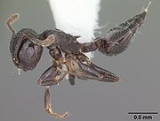
Crematogaster ashmeadi
Encyclopedia
Crematogaster ashmeadi, commonly known as the acrobat ant, is an arboreal ant
widespread in the Southeastern United States
. It nests and forages almost exclusively above ground level, often found in treetops and on liana
s. It is one of eleven species
in the genus
Crematogaster
that is native to eastern North America
. It is the most dominant arboreal ant in the pine forests of the coastal plains of northern Florida
. Colonies of these ants inhabit a majority of pine
trees in the area, living in chambers in the outer bark of living trees that have been abandoned by bark-mining caterpillar
s, usually of the family Cossidae
. C. ashmeadi does little to no excavation of its own, relying solely on chambers bored out by other insects.
Ant
Ants are social insects of the family Formicidae and, along with the related wasps and bees, belong to the order Hymenoptera. Ants evolved from wasp-like ancestors in the mid-Cretaceous period between 110 and 130 million years ago and diversified after the rise of flowering plants. More than...
widespread in the Southeastern United States
Southeastern United States
The Southeastern United States, colloquially referred to as the Southeast, is the eastern portion of the Southern United States. It is one of the most populous regions in the United States of America....
. It nests and forages almost exclusively above ground level, often found in treetops and on liana
Liana
A liana is any of various long-stemmed, woody vines that are rooted in the soil at ground level and use trees, as well as other means of vertical support, to climb up to the canopy to get access to well-lit areas of the forest. Lianas are especially characteristic of tropical moist deciduous...
s. It is one of eleven species
Species
In biology, a species is one of the basic units of biological classification and a taxonomic rank. A species is often defined as a group of organisms capable of interbreeding and producing fertile offspring. While in many cases this definition is adequate, more precise or differing measures are...
in the genus
Genus
In biology, a genus is a low-level taxonomic rank used in the biological classification of living and fossil organisms, which is an example of definition by genus and differentia...
Crematogaster
Crematogaster
Crematogaster is an ecologically diverse genus of ants found worldwide, which are characterised by a distinctive heart-shaped gaster , which gives one of their common names, Valentine Ant. It is the only genus of the tribus Crematogastrini. Most of species are arboreal...
that is native to eastern North America
North America
North America is a continent wholly within the Northern Hemisphere and almost wholly within the Western Hemisphere. It is also considered a northern subcontinent of the Americas...
. It is the most dominant arboreal ant in the pine forests of the coastal plains of northern Florida
Florida
Florida is a state in the southeastern United States, located on the nation's Atlantic and Gulf coasts. It is bordered to the west by the Gulf of Mexico, to the north by Alabama and Georgia and to the east by the Atlantic Ocean. With a population of 18,801,310 as measured by the 2010 census, it...
. Colonies of these ants inhabit a majority of pine
Pine
Pines are trees in the genus Pinus ,in the family Pinaceae. They make up the monotypic subfamily Pinoideae. There are about 115 species of pine, although different authorities accept between 105 and 125 species.-Etymology:...
trees in the area, living in chambers in the outer bark of living trees that have been abandoned by bark-mining caterpillar
Caterpillar
Caterpillars are the larval form of members of the order Lepidoptera . They are mostly herbivorous in food habit, although some species are insectivorous. Caterpillars are voracious feeders and many of them are considered to be pests in agriculture...
s, usually of the family Cossidae
Cossidae
Cossidae, the cossid millers or carpenter millers, make up a family of mostly large miller moths. Ths family contains over 110 genera with almost 700 known species, and many more species await description...
. C. ashmeadi does little to no excavation of its own, relying solely on chambers bored out by other insects.

